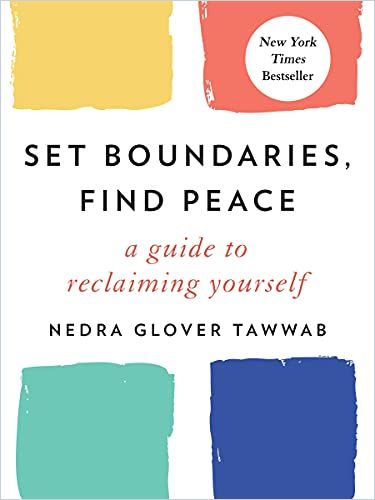For many people, a lack of healthy boundaries underlies anxiety and burnout. Relationship expert Nedra Glover Tawwab teaches how to restore sanity by setting and enforcing limits with family, friends, co-workers and managers.

When It’s Time to Draw a Line
Relationship expert Nedra Glover Tawwab had already established herself as a holistic counselor when, in 2017, she started posting on Instagram about mental health topics. Four years later, after a 2019 New York Times article on Instagram therapists featured her account, she broke a million followers. Today, 1.5 million people subscribe to Tawwab’s Insta feed for her quickly digestible, bullet-pointed posts offering direct, actionable advice for mental and emotional health.
Tawwab’s 2021 best-selling book on boundaries reflects much of the feel and format of her Instagram posts: staccato sentences and simplified content broken out into lists, paired with an empathic, practical tone. The book’s first part sets out the concepts of boundaries – a practical definition, explanations of the six types of boundaries, obstacles to enforcing them and what can happen when violations take place. The second part delves into the settings and relationships where boundaries count most. Tawwab offers helpful illustrative stories from her own practice and specific advice for putting boundaries into action, even down to phrases to use.
The costs and causes of weak boundaries
Tawwab defines boundaries as statements of expectations and needs that protect your mental and emotional safety and comfort. Boundaries represent a form of self-care, she writes, because by saying no to others, you can better attend to your own needs.
Tawwab counts overwhelm, resentment and avoidance among the primary signals of a problem that needs attention. Failing to establish boundaries can also lead to negative health outcomes, such as burnout, or exacerbate mental health issues, including anxiety and depression.
Communicating our boundaries isn’t easy, but without it, we set ourselves up for long-term suffering.Nedra Glover Tawwab
Many people struggle to set limits in certain situations or with certain people. Tawwab points out that boundary issues can arise, in particular, for people who feel guilty about being rude or displeasing others and for those who feel self-worth only when serving others. A history of childhood trauma can underlie the difficulty to set and honor boundaries, Tawwab says. Those who’ve experienced childhood trauma frequently encounter physical, sexual or emotional boundary violations as adults; they also tend to overshare, loan money to unreliable people or work too much – all signs of weak boundaries.
Recognizing violations
In a chapter on recognizing boundary violations, Tawwab highlights behavior patterns that people often don’t identify as issues of boundaries – such as sending mixed messages, guilt-tripping and codependency. In the intellectual arena, Tawwab emphasizes every person’s right to hold an independent opinion; she categorizes ridiculing or belittling an idea, for example, as a violation of intellectual boundaries. Emotional boundary violations include a person telling other people how they should feel. Sexual boundary violations occur when a person touches another, makes sexual comments or engages in sexual activity without consent.
Confidence in your boundaries is the cure for self-sabotage. Nedra Glover Tawwab
Violations of material boundaries include treating someone’s possessions carelessly or demanding that a person share belongings. And people who demand that someone drop everything to help them, or call or email excessively, are violating time boundaries. Common boundary violations among friends include pressure to lend possessions or money, expecting advice about romantic distress, giving or receiving unsolicited advice, and neediness.
Setting limits
Tawwab offers granular advice for setting healthy boundaries with family members and friends, in your professional life and romantic relationships, and with yourself. She offers three keys to setting limits and ensuring people respect them: Be clear, be direct, and don’t try to avoid the discomfort and guilt that often accompany protecting your boundaries.
When you communicate your boundaries, stay calm and be straightforward. State your needs and expectations clearly. Then take action to enforce the boundaries you’ve stated. Don’t allow people to violate them. Difficult individuals might test your limits, question your actions, get defensive or cut off communication – you’ll have to accept these responses as the price of setting boundaries. If someone continually violates your boundaries, reduce your interactions with the person or let the person know you’ll end the relationship if necessary.
Creating healthy boundaries leads to feeling safe, loved, calm and respected.Nedra Glover Tawwab
In a romantic relationship, Tawwab recommends focusing on building healthy communication. Express your needs, and don’t expect your partner to fulfill every one of them. Don’t allow little issues to build up and create resentment. If your relationship is healthy, setting boundaries shouldn’t cause negativity or disruption.
Strengthen your boundaries with yourself by meeting your own expectations, such as maintaining healthy financial habits, resting when your body needs it or seeing a therapist regularly. Create boundaries for yourself regarding the use of electronic devices and social media. Turn off news alerts and take scheduled breaks.
Compassion and insight
Tawwab displays a rich understanding of people’s vulnerability and need for connection. In expressing that need, many don’t realize they protect themselves insufficiently. Her clear compassion for this common human mistake helps readers recognize their own behaviors, as do her psychological insights, practical advice and conversational tone. After-chapter exercises assist readers in translating new knowledge into action. Some might find the content repetitive and oversimplified, but the value of the material for people who are experiencing the pain and chaos of porous boundaries will likely outweigh these criticisms.
Tawwab also wrote the companion Set Boundaries Workbook. Other valuable titles on healthy boundary-setting include Boundaries by Henry Cloud and John Townsend, Boundaries: Where You End and I Begin by Anne Katherine and Better Boundaries by Jan Black. Although not recent, these titles remain highly recommended on the subject.













